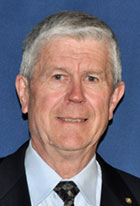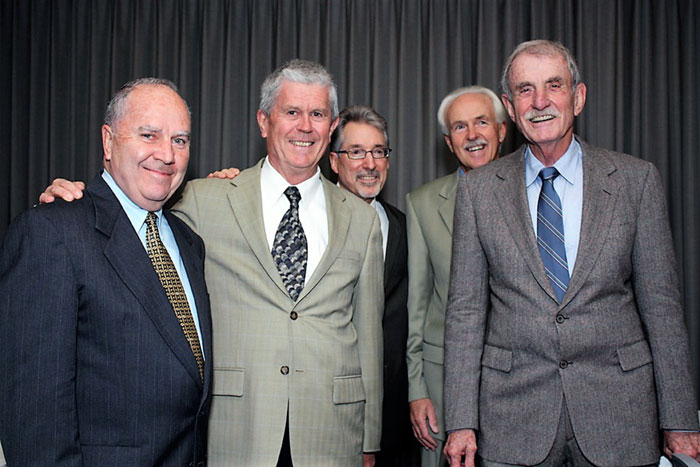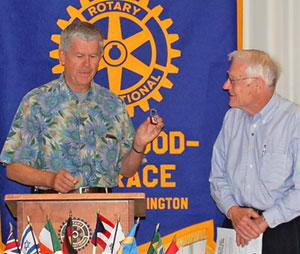
Dr. Norbert Hertl, an alumnus of our Endodontics Class of 1979, served on our affiliate faculty for two decades. He also collaborated with the late Dr. James Steiner on a detailed history of our Department of Endodontics, a link to which can be found on the department’s homepage. Here he shares his memories, which include many of the department’s most iconic figures.
As a refugee of World War II and a young immigrant from Germany living in Huntsville, Ala., with my sister’s family, I joined the U.S. Air Force in 1962. After some training, my sergeant made it possible for me to go to a course for dental assistants instead of becoming a medical orderly. My four years in a large dental clinic at Langley Air Force Base in Virginia were very enjoyable and educational. My work habits seemed to please the oral surgeon who was stationed there. He recommended that I take college courses in the evening offered by the College of William and Mary, and he encouraged me to apply to Ohio State University, where he had attended. He also offered financial help if I should need it.
After a bachelor’s degree in zoology at Ohio State University, I still hesitated to take on the daunting task and cost of dental school. The National Forest Service could be another option. I applied to dental school anyway and was accepted. Ironically, on the first day of class I read a note on the inside of my locker door: “It is never too late for forestry.”
My study habits and my interest in the subject helped me graduate in 1973 near the top of the class of 150. There were no women or students of color.
After four years as a dentist in the Public Health Service in Boston and Washington, D.C., I was accepted to the Graduate Program in Endodontics at the University of Washington in 1977.
We learned to no longer rely only on textbooks but on research data, which should be the basis for our textbooks and for the treatment of our patients. We were encouraged to do our own research project, which I did under the patient guidance of Dr. Henry Van Hassel and Dr. Jack Nichols.

Our training was consistent, detailed, all-encompassing, research-based, firm, and kind. Dr. Eugene Natkin, the chair of the department, was on sabbatical during my first year. Dr. Gerald Harrington was in charge with the support of Dr. Robert Oswald, Dr. Van Hassel, and Dr. David Pitts. Their knowledge and patience seemed endless. We were treated with respect. I don’t remember any major disagreements or unkind words. They made the lectures interesting, the seminars stimulating, and they gave us much freedom while treating patients. Dr. Harrington was an expert in providing us with patients with the right difficulty level to match our abilities.
Dr. Van Hassel had a PhD in physiology and biophysics. He was on the full-time faculty from 1967 to 1981. We benefited greatly from his recent research and expertise in pulp physiology. I always admired the precision of his scientific arguments. He was a great calming influence during the frustrating periods of my research project. Between 1965 and 1980, the U.S. Public Health Service sent one commissioned officer per year to our program and paid all the expenses. Dr. Van Hassel was the first student from the Public Health Service to graduate, in 1967. It was my turn from 1977 to 1979.
Dr. Harrington had been on the faculty since graduating from the program in 1969. He seemed to know every endodontist on the faculty of other dental schools and every major researcher in dentistry. He also seemed to know every pertinent research article ever published which related to our field. He was able to pass on his knowledge and wisdom in such a gradual and measured way as to not overwhelm us and make us feel discouraged. No one will ever know how he found the time to teach all the courses, do all the research, write all the articles, supervise all those students, and fulfill all his administrative duties as Director of the Endodontic Graduate Program and later as Chair of the department.

Dr. Oswald had joined the faculty in 1974 after graduating from Columbia University. He was very involved in research at the time of my stay, but always had time for us. He was very patient and supportive in the clinic. I remember his many debates with Dr. Van Hassel on various subjects. After I entered private practice, we met for several years on the ski slopes of Mission Ridge during our yearly ski-endo meetings which he helped to organize.
Dr. Pitts had just graduated from the program and joined the faculty in 1977. I remember him mostly from the clinic where he patiently guided us through difficult procedures. I still remember his demonstration of the best way to trim a gutta percha point and the proper time to dip it into chloroform before forming it in the root canal.
Dr. Natkin was back during my second year in the program. He had this wonderful combination of extensive knowledge in his field and the ability to transmit it to students during lively and stimulating lectures. I remember attending some of his lectures to the undergraduate dental students just because I enjoyed his style of teaching. In 1962 he was the first graduate of the program. He joined the faculty in that year and became Chair in 1967. One of his many accomplishments that benefited students was the development of self-instructional syllabi for the predoctoral courses. We graduate students also had to read them, and we gained a great deal of detailed understanding in our field. It was a pleasure to attend lectures on his favorite topic, dental radiology.
Dr. John Ingle was Chair of the Department of Periodontics and Endodontics from 1959 until 1964. He created the Graduate Program in Endodontics in 1959. In 1964 Dr. Ingle left to become Dean of the School of Dentistry at the University of Southern California. I remember attending several of his lectures during his many return visits to Seattle. He also used some of my clinical cases for his textbook on endodontics.
For about 20 years while in private practice, I volunteered as an Affiliate Associate Professor, supervising graduate students in the graduate clinic. It was a small way to pay back what the School had done for me. My other contribution to the School was in 2012, writing the history of the Department of Endodontics, which Dr. James Steiner and I had started but which I had to finish after his death in 2010. All of the above-mentioned faculty and the new faculty members under Dr. James Johnson, the new Chair, were of great help in this project. Dr. Steiner also joined my Rotary Club in Edmonds after his retirement.
Students can never thank their teachers enough for the positive impact they have on their lives. Teachers should know that students are very thankful and appreciative but don’t often take the time to express it.